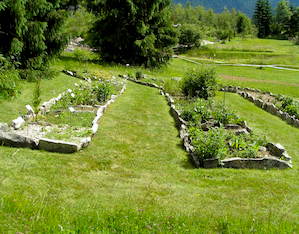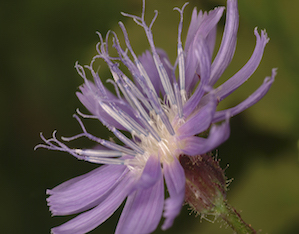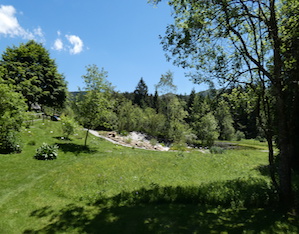This garden was set up for the purposes of education, scientific study and conservation, offering a chance to study the local flora and admire rare and autochthonous species. The garden’s modern subdivision into habitat beds is a perfect way to learn about and explore otherwise hard-to-access habitats.
Conceived in 1972 by University of Padua Professor Giovanni Giorgio Lorenzoni, to whose memory it is dedicated, and by Giovanni Zanardo, Inspector of the State Forestry Corps, the gardens were inaugurated in 1995, and are under “Veneto Agricoltura” management. Centrally-located on the Cansiglio Plateau, the garden occupies a two-hectare expanse of limestone at an altitude of some 1,000 metres above sea level that is divided up into multiple levels of beds, meadowland, pastures and wooded areas, offering a microcosm of the vast, orographically-complex border area of the Prealpi Carniche Cansiglio-Col Nudo-Cavallo mountainous massif. Showcasing a number of highly-diverse habitats, it is located between the Alpine and Dinaric-Balkan biogeographic regions, straddling the provinces of Belluno, Treviso and Pordenone. The area’s Alpine foothills, just beyond the Venetian plain, ensure abundant rainfall from humid oceanic currents, resulting in high levels of biodiversity and generally lush vegetation. The garden has collected close to a thousand species of plants exclusively from the uniquehabitat of centuries-old forest on the Cansiglio karst plateau, and from the Col Nudo-Cavallo mountain massif. Alpine environments, wetland vegetation, beech, spruce and fir woods, medicinal plants, arid environments and numerous threatened species are all on featured.
Highlights

Habitats
The garden’s alpine habitats include typical Italian types known locally as firmeto, seslerieto, mugheta, ghiaioni and macereti, as well as small snowy valleys and rocky vegetation; humid habitats include molinieto and peat bogs, while woodland formations include beech woodland (Fagus sylvatica), spruce woodland (Picea excelsa), and silver fir woodland (Abies alba).

Endangered Species
The flower beds showcase a great many endangered species: Drosera rotundifolia, Rhynchospora alba, Iris cengialti, Hottonia palustris, Gentiana pneumonanthe, Menyanthes trifoliata, Cypripedium calceolus, Lilium carniolicum, Primula wulfeniana, and Alyssum ovirense.

The Cansiglio Plateau
The forest of San Marco and the Cansiglio Woods cover some 6,000 hectares of karst plateau, riddled with complex underground hydrographical features. During the Republic of Venice, the woods were known as the “bosco da reme di San Marco”, its rich beech forest used to manufacture oars for galleys.
 Giardino Botanico Alpino “Giangio Lorenzoni”
Contacts
Giardino Botanico Alpino “Giangio Lorenzoni”
Contacts
 Giardino Botanico Alpino “Giangio Lorenzoni”
Opening times and prices
Giardino Botanico Alpino “Giangio Lorenzoni”
Opening times and prices
Opening hours
The Garden is open to the public from the last Sunday in May to the first Sunday in October.
- weekdays from 10.00 a.m. to 12.00 noon and from 1.00 p.m. to 5.00 p.m.
- Saturday and Sunday from 10 a.m. to 1 p.m. and from 2 p.m. to 6 p.m.
- closed on Mondays and Tuesdays.
Guided tours
- every Sunday from June to September at 3.00 p.m.; in August also Saturday (3.00 p.m.) and Sunday morning (10.30 a.m.). The visit is included in the cost of the entrance ticket.
Pricing
- Full price: € 3,00
- Reduced (young people 14-18 years old, group of young people up to 14 years old accompanied): € 1,00
- Reduced price for groups € 2,00 (group of>10 people).
- Children up to 14 years of age, disabled persons and their carer: free admission
 Giardino Botanico Alpino “Giangio Lorenzoni”
How to get there
Giardino Botanico Alpino “Giangio Lorenzoni”
How to get there
Address
Via Cansiglio
32010 , Pian del Cansiglio (BL)
Latitude: 46.0733562
Longitude: 12.4163242
How to arrive by road
From Verona – Vicenza – Padua – Venice – Treviso:
- Follow the A27 motorway as far as the Vittorio Veneto Sud exit; take the SS 422 del Cansiglio road as far as the Valico della Crosetta pass.
From Trieste – Udine – Pordenone:
- Follow the A4 motorway as far as the tollgate of Portogruaro; take the A28 motorway as far as the exit of Conegliano, and then continue on the A27 motorway as far as the exit of Vittorio Veneto Sud, continuing on the state road 422 del Cansiglio, as far as the pass of Crosetta.
From Belluno:
- Follow the A27 motorway and exit at the Fadalto toll booth; take the SS 51 until Bivio La Secca, then take the SS 422 towards Tambre, Pian Osteria, Pian Cansiglio.
How to arrive by train
- From the Padova-Belluno-Ponte Alpi line get off at Ponte Alpi. From here take the Dolomitibus (Ponte Alpi – Tambre – Cansiglio line)
- On the Venezia-Belluno line get off at the station for L’Alpago. From here take the Dolomitibus (Line for Tambre – Cansiglio)
 Giardino Botanico Alpino “Giangio Lorenzoni”
Services/Accessibility
Giardino Botanico Alpino “Giangio Lorenzoni”
Services/Accessibility
Services
At the entrance it is possible to buy informative material about Cansiglio and the Alpine Botanical Garden as well as gadgets in Cansiglio wood.
 Giardino Botanico Alpino “Giangio Lorenzoni”
Private events
Giardino Botanico Alpino “Giangio Lorenzoni”
Private events
 Giardino Botanico Alpino “Giangio Lorenzoni”
Itineraries
Giardino Botanico Alpino “Giangio Lorenzoni”
Itineraries
You could find the garden in these itineraries
 Favorite saving result
Favorite saving result
 Warning!
Warning!
You've have to sign up or sign in to add this element to your favorites.
